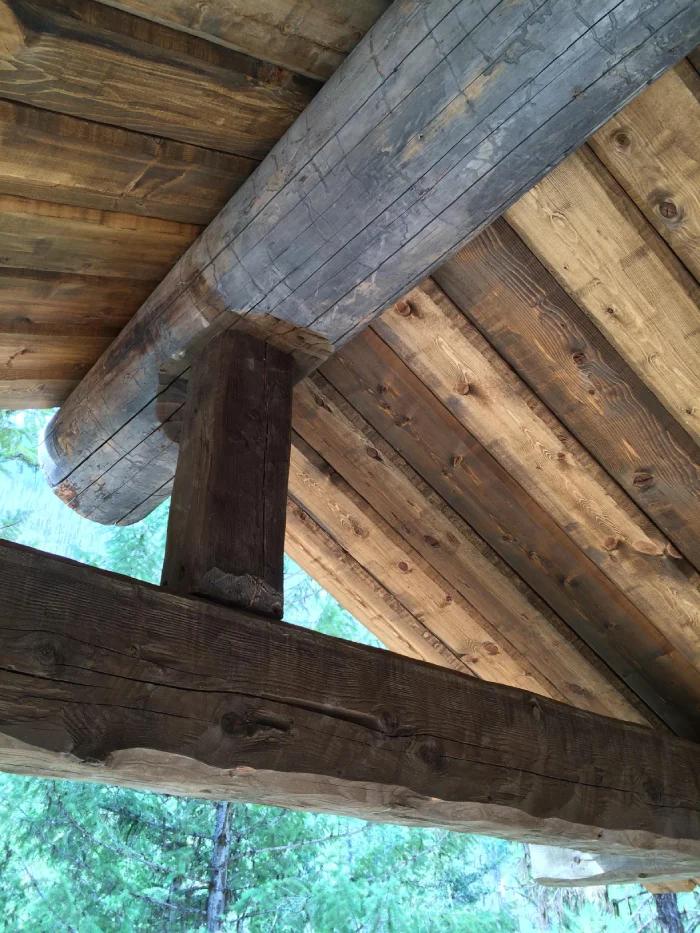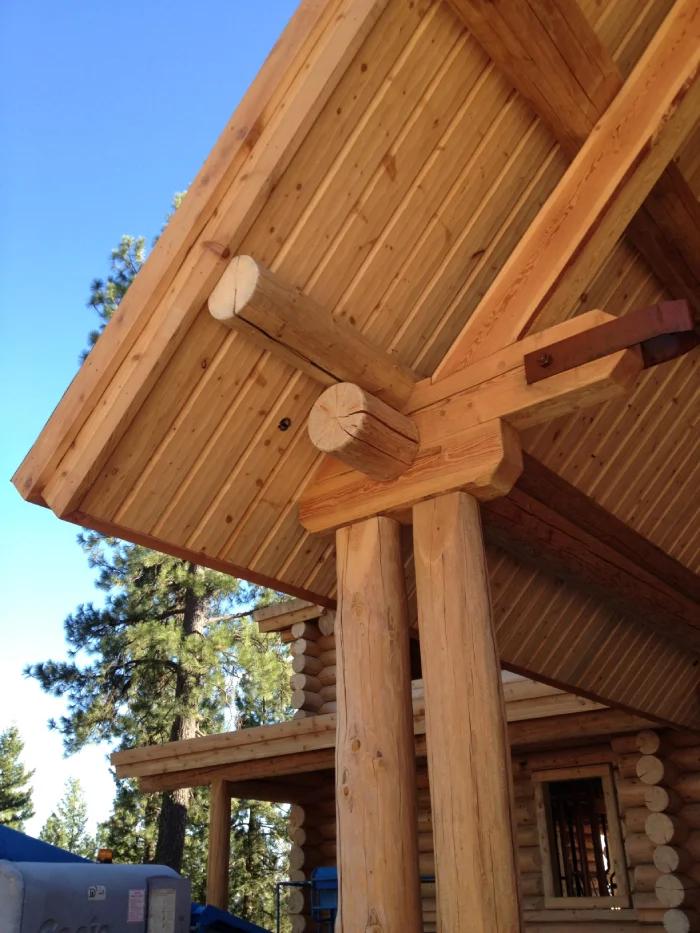Understanding the R-value of wood is crucial to building an energy-efficient home. The R-value measures wood's thermal resistance or its ability to resist heat flow. The higher the R-value, the better the insulation properties. For instance, pine wood has an R-value of 1.35 per inch, meaning a six-inch log would provide an R-value of 8.
Thoughtful design plays a significant role in maximizing a log home's energy efficiency. According to ASHRAE, about 4% of an opaque wall consists of headers, which can impact overall insulation. Builders can improve the wall's R-value by using engineered wood headers, which carry higher loads and allow more space for cavity insulation. This strategic approach ensures that log homes look beautiful and perform efficiently in maintaining comfortable indoor temperatures.

What Is R-Value?
R-value measures a material's resistance to heat flow. The higher the R-value, the better the material insulates. R-value is crucial in the construction industry for evaluating the thermal efficiency of materials like prebuilt log-wall panels and thermally treated wood. Higher R-values translate to better energy efficiency and comfort in buildings.
How R-Value Applies to Wood
Wood's R-value can vary based on factors like density, moisture content, and thickness. Generally, hardwoods provide better insulation than softwoods. For instance, oak has an R-value of 1.41 per inch, while pine has an R-value of 0.71 per inch. Understanding these values helps homeowners and architects choose the most thermally effective materials for projects, from panelized full log shear walls to reclaimed wood features.
Builders must consider the R-value when designing thermal efficient roof constructions and log homes. For example, an 8-inch log of average softwood has an R-value of approximately 11.3. Insulating log options can increase this value by over 100%, ensuring compliance with new federal energy codes. This information is particularly valuable for contractors and architects establishing a builder-dealer network focused on sustainable and energy-efficient construction.
Knowing the R-value of different wood types can help make informed decisions about material selection for both B2B and B2C audiences.
Thermal Properties of Wood
Understanding wood's thermal properties is crucial for designing energy-efficient buildings. Wood's natural insulation capabilities contribute significantly to energy savings.
Thermal Conductivity in Wood
Wood possesses low thermal conductivity, meaning it does not readily transfer heat. This low conductivity stems from wood's open cellular structure, which traps air pockets and minimizes heat conduction. Materials designed for thermal efficient roof construction, such as thermally treated wood, benefit from these properties, contributing to stable indoor temperatures and reduced energy costs. The efficacy of prebuilt log-wall panels and panelized full log shear walls depends largely on this characteristic.

The Impact of Moisture on Wood's R-Value
Moisture content directly influences wood's R-value. Higher moisture levels decrease a wood’s insulation capabilities, affecting its thermal resistance. For architects and builders, selecting wood with optimal moisture content, such as reclaimed or thermally treated wood, ensures better insulation performance. Accurate calculations of R-values for different wood types help inform decisions in constructing energy-efficient log homes.
Enhancing the Energy Efficiency of Wood
Increasing wood's energy efficiency boosts thermal performance in log homes and structures with wood elements. Several techniques and considerations can further improve wood's insulation properties.
Techniques to Increase Wood's R-Value
- Prebuilt Log-Wall Panels: Using prebuilt log-wall panels can ensure better R-value consistency and reduce thermal bridging. These panels integrate insulation materials directly, providing higher R-values in a controlled manufacturing process.
- Thermally Treated Wood: Thermally treated wood undergoes a heating process that enhances its insulation properties, making it less susceptible to moisture.
- Reclaimed Wood: Reclaimed wood from old structures often has a lower moisture content, which can improve its insulation performance. Sustainable architects and builders can use this wood to increase environmental benefits and energy efficiency.
- Engineered Wood Headers: Engineered wood headers allow for higher load capacities with reduced size, freeing up space for additional insulation. This design optimizes the balance between structural integrity and thermal efficiency.
- Cavity Insulation in Headers: Builders can increase the overall R-value by incorporating cavity insulation within headers. Single-ply and double-ply headers allow for different levels of insulation addition, depending on the wall thickness available.
The Role of Continuous Insulation
Continuous insulation (CI) covers the entire building envelope with insulation layers, minimizing thermal bridging. While it may seem complex, the benefits often outweigh the concerns.
- Thermal Bridging Reduction: CI reduces heat transfer through the structural support members, maintaining a more consistent thermal barrier across the building. This is particularly effective in thermal efficient roof construction and panelized full log shear walls.
- R-value Enhancement: Using CI can elevate the overall R-value of the building assembly. Combining CI with cavity insulation in reclaimed or thermally treated wood structures can yield significant energy efficiency gains.
- Compliance with Energy Codes: Adhering to modern, stringent energy codes often requires CI to meet minimum R-values. The incorporation of CI helps architects and builders seamlessly comply with these requirements.
- Integration with Modern Building Techniques: CI aligns well with modern construction methods like prebuilt log-wall panels. It simplifies the integration of highly insulated materials into the design, allowing for streamlined installation and improved performance.
Architects can design more energy-efficient wood structures by focusing on these advanced techniques and understanding the crucial role of continuous insulation. Builders and homeowners benefit from improved thermal performance, lowering energy costs and enhancing indoor comfort.
Applications of Wood in Energy-Efficient Construction
Benefits of Using Wood for Insulation
Wood offers numerous benefits as an insulating material in energy-efficient construction. As a renewable and sustainable resource, wood insulation aligns with environmentally-friendly practices. Its thermal performance, indicated by its R-value, significantly reduces energy consumption and lowers utility costs. For architects, wood's versatility makes it ideal for integrating into various designs, such as prebuilt log-wall panels and panelized full log shear walls.
Durability and longevity are key advantages, as wood insulation can retain its properties for decades. Additionally, wood is a natural, non-toxic material, free from harmful chemicals found in synthetic insulations, making it safer for indoor environments.
Challenges in Using Wood for Insulation
Despite its benefits, wood insulation presents some challenges in energy-efficient construction. One of the primary concerns is the variability in R-value between hardwood and softwood species, necessitating careful selection based on specific insulation needs. For builders and contractors, ensuring the consistent quality and performance of wood insulation materials can be complex.
Moisture content and susceptibility to pests also pose potential issues. Wood can warp or deteriorate if not adequately treated or shielded, affecting its insulating properties. For architects and developers, integrating wood into existing thermal efficient roof construction and cavity insulation in headers may require additional expertise and careful planning to maximize effectiveness and meet energy codes.
Conclusion
Understanding the R-value of wood is crucial for building energy-efficient log homes. Builders can optimize insulation by considering factors like wood type density and moisture content. Wood's renewable nature and thermal performance make it an excellent choice for sustainable construction. However, addressing challenges such as R-value variability and susceptibility to pests is essential. Advanced techniques like reclaimed or thermally treated wood can enhance energy performance. With careful planning architects, builders, and homeowners can achieve improved thermal performance, lower energy costs, and a more comfortable indoor environment.
Project Management
Lead Designer & CAD Technician
After graduating with a Master's Degree in Wood Engineering, Milan started his career by traveling abroad to apprentice with Brian Schafer, Principal of Big Cabin. As an expert in the industry for over a decade now, his passion for log and timber home construction grew deeply throughout his career and ingrained his knowledge of drafting, project management, and roofing design.